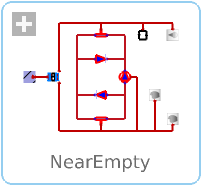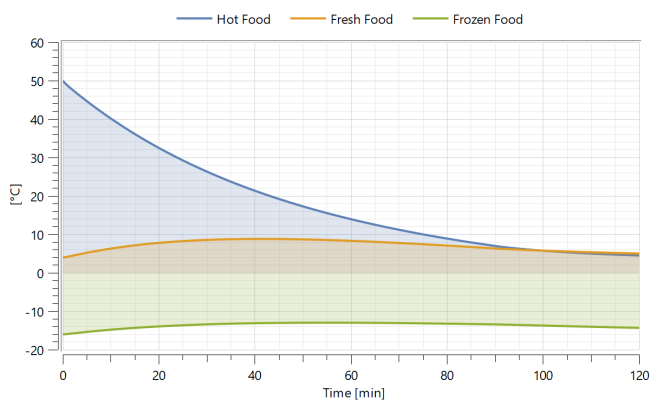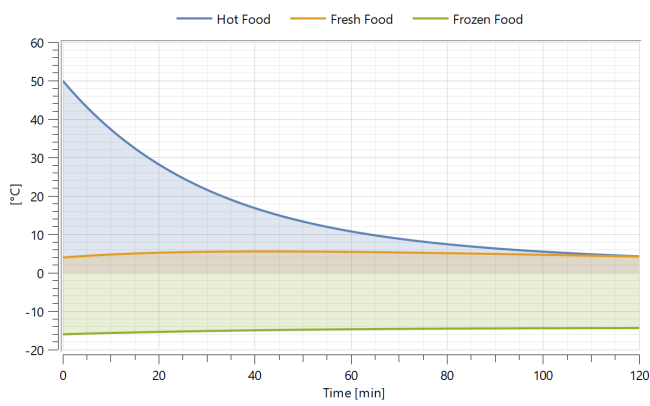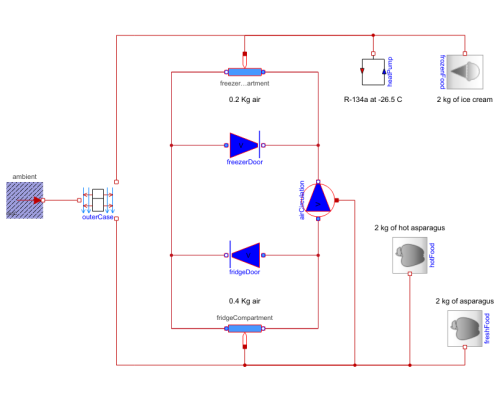WOLFRAM SYSTEM MODELER
NearEmptyModel simulating the effect of adding hot food to nearly-empty refrigerator |
|
Diagram
Wolfram Language

SystemModel["IndustryExamples.ConsumerProducts.Refrigerator.NearEmpty"]

Information
This model should be compared with the HotFood model, which simulates the addition of hot food to a normally loaded refrigerator.
The other model in this example is DoorOpening, which simulates the effects of opening and closing the compartment doors.
Simulation
The model simulates the effect of a piece of hot food added at t=0 seconds to a refrigerator that is nearly empty, with only a small amount of fresh and frozen food stored in the compartments.
To simulate the model, click the Simulate button:
By default, the model is simulated over a period of 7200 seconds.
Visualization
After simulating the model, look at the displayed plot of the food and air temperatures in the refrigerator compartment. The plot looks like this:

You can see that the fresh food temperature increases by about 7 K, outside acceptable limits. The low thermal mass of the near-empty refrigerator also leads to excessively frequent thermostat switching, visible after t=5500 seconds.
By simulating the HotFood model, you can see the effect of adding hot food to a normally loaded refrigerator instead of a near-empty one:

You can see that, in the normally loaded refrigerator, the fresh food temperature increases by about 2 K, which is within acceptable limits.
Other Scenario
Try simulating the other model in this example, DoorOpening, to explore the effects of opening and closing the refrigerator and freezer compartment doors.
Parameters (3)
| heatCapacityFrozenFood |
Value: 3340 Type: HeatCapacity (J/K) Description: Frozen food heat capacity |
|---|---|
| heatCapacityHotFood |
Value: 7880 Type: HeatCapacity (J/K) Description: Frozen food heat capacity |
| heatCapacityFreshFood |
Value: 7880 Type: HeatCapacity (J/K) Description: Fresh food heat capacity |
Components (11)
| outerCase |
Type: OuterCase Description: Household refrigerator case and insulation |
|
|---|---|---|
| frozenFood |
Type: ConvectionCooledFood Description: Food cooled by air |
|
| freshFood |
Type: ConvectionCooledFood Description: Food cooled by air |
|
| heatPump |
Type: Cooling Description: Thermostat-controlled cooling |
|
| ambient |
Type: FixedTemperature Description: Fixed temperature boundary condition in degree Celsius |
|
| freezerCompartment |
Type: Pipe Description: Pipe with optional heat exchange |
|
| fridgeCompartment |
Type: Pipe Description: Pipe with optional heat exchange |
|
| airCirculation |
Type: AirCirculation Description: Thermostat-controlled air circulation between compartments |
|
| freezerDoor |
Type: CompartmentDoor Description: Refrigerator or freezer compartment door |
|
| fridgeDoor |
Type: CompartmentDoor Description: Refrigerator or freezer compartment door |
|
| hotFood |
Type: ConvectionCooledFood Description: Food cooled by air |

